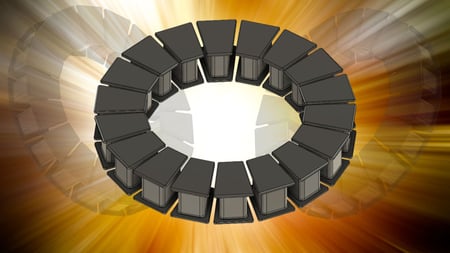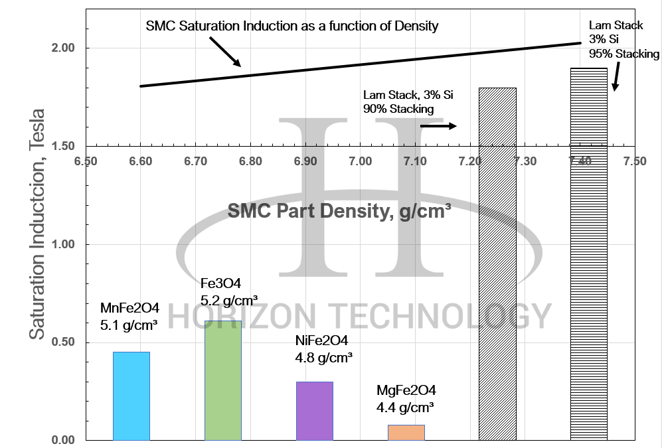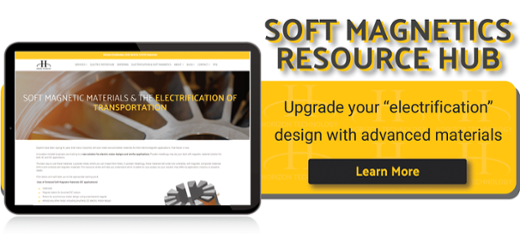Increasing energy prices and the desire to reduce green house gases emissions are forcing all manufacturing sectors to invest in new designs that maximize performance while minimizing energy consumption. Electric motors are a prime example, it is estimated that electric motors consume approximately 50% of the electricity generated on a world-wide basis. Combine this with the fact that 60% of all electricity produced is generated by fossil fuels. Thus, improvements in electric motor efficiency can potentially lead to significant reductions in green house gas emissions.
The question is how can electric motor efficiency be improved? Traditional stamped steel radial flux design motors have reached their pinnacle of performance and efficiency but there is more to be achieved. New topologies in radial flux and axial flux motors are two examples of how rethinking electric motor design can lead to improvements in performance while using less energy.
Lets spin further into the future and discover the advantages of yokeless axial flux motors and how pairing them with SMCs can bring your electric motor design to a whole new level.
What Is the Difference Between Axial Flux & Yokeless Axial Flux Motors?
Axial Flux Motor
In an axial flux motor, the magnetic flux generated is perpendicular to the axis of rotation. It has a more efficient use of the copper (no end-turns), which provides an opportunity to increase the number of turns and decrease heat generation. Couple these advantages with simplified winding and assembly - thus axial flux motors opens the door to next generation efficiency gains.
In traditional axial flux motor designs, (see below), the yoke connects all the stator teeth together. The flux still goes directly from one pole to another thru the airgap. The consequence of this is: high active winding and less overhang of the copper wire. The back iron is there to hold the various teeth in place. This is actually one problem with traditional axial flux designs. Specifically, maintaining the proper air gap from tooth to tooth in this design and potential for stress induced deflections of the stator.
Yokeless Axial Flux Motor
 As the name implies, a yokeless axial flux motor doesn’t have a stator yoke. Due to the absence of a yoke, the stator teeth need to be assembled in an alternative way. In a yokeless axial flux motor, the stator is made of individual stator teeth that are not connected to any back iron. Magnets are then placed on the top and bottom of the rotor which interacts with the flux created by each individual segment.
As the name implies, a yokeless axial flux motor doesn’t have a stator yoke. Due to the absence of a yoke, the stator teeth need to be assembled in an alternative way. In a yokeless axial flux motor, the stator is made of individual stator teeth that are not connected to any back iron. Magnets are then placed on the top and bottom of the rotor which interacts with the flux created by each individual segment.
In a yokeless axial flux motor, the flux travels from one stator tooth to another stator tooth, creating a magnetic field - which interacts with the magnetic field(s) on the rotor. Advantages of this design are the ability to have the flux interact with the two sets of magnets, thus significantly increasing the torque density of the design – meaning less weight, less current, less losses, and more torque. A study conducted by EM WORKS showed that this design has significant advantages in both performance and weight savings.
.jpg?width=715&height=402&name=Paradigm%20Shift%20Blog%20%20(2).jpg)
Why Choose Yokeless over Regular Axial Flux Motors?
If you follow electric motor trends, you’ve probably heard a lot from YASA and Magnax about yokeless axial flux motors. So, what makes them superior?
The design of a yokeless axial flux motor allows for higher torque density, with reduced weight, space volume, and electrical consumption. This also allows for total weight savings due to the reduced mass of the motor - there is a multiplying effect of reduced battery mass and reduced structural mass.
Some real-life applications of this are:
- The reduced weight in an electric car which extends range between charges.
- In drone technology a higher torque density via a smaller motor with reduced mass - results in a higher payload.
- Hand Tools made with yokeless axial flux motors are more lightweight than their current radial flux design, creating a hand tool that reduces fatigue.
- In refrigerators and other household applications, such as HVAC units, a yokeless motor uses less energy, leading to lower electric bills.
Yokeless axial flux motors may also have other advantages, such as:
- Easier fabrication and winding
Elimination of the bobbins and wind directly onto the stator tooth to achieve a higher winding density eliminating the potential air gap effect of the bobbin.
How can SMC enable your design
Using soft magnetic composites in a yokeless axial flux motor drives down cost while elevating performance.
The cost effective, net-shape making capabilities of SMC materials are unparalleled by other processing alternatives. Your unique shape is easily created through powder metallurgy/SMC, which enables 3-D flux carrying capabilities and rounded corners. Compared to electrical steel laminations requiring stamping, assembly, welding, staking, machining – it’s clear why SMC is the obvious choice for manufacturability.
SMCs are a mono-structure eliminating the magneto-striction acoustics inherent in laminated assemblies – promoting less NVH (Noise Vibration & Harshness)
Higher Saturation resulting in Higher Torque
As you can see below, using SMCs can provide your axial flux motor with higher saturation, leading to higher torque:

Reduced Need For Cooling
The power density of your electric motor is strongly related to the performance of its cooling system. In a yokeless axial flux motor, the cooling is aided through self-ventilation of the rotor discs. Similar to axial flux designs, yokeless axial flux designs have no end-turn effect - further reducing the source of heat.
The inherent reduction of eddy current losses with SMCs further reduce the need for large and costly cooling systems – reducing overall heat while increasing overall performance.
Simplified Supply Chain
SMC powders and processing capacities are abundantly available worldwide offering a simplified supply chain - unlike lamination materials, which are currently in short unlike lamination materials, which are currently in short supply.
Green Technology
SMCs offer a 17% reduction in energy costs to produce over other metal forming technologies – is easily recyclable and eliminates waste. Couple this with the opportunity for improved performance and you have a clear choice of technology for the future.
Ready for Innovation?
Adding SMCs to your design opens the door to innovation - unlocking your creative freedom.
If you’d like to learn even more about how soft magnetic composites can enable your electric motor, check out our Resource Hub:



